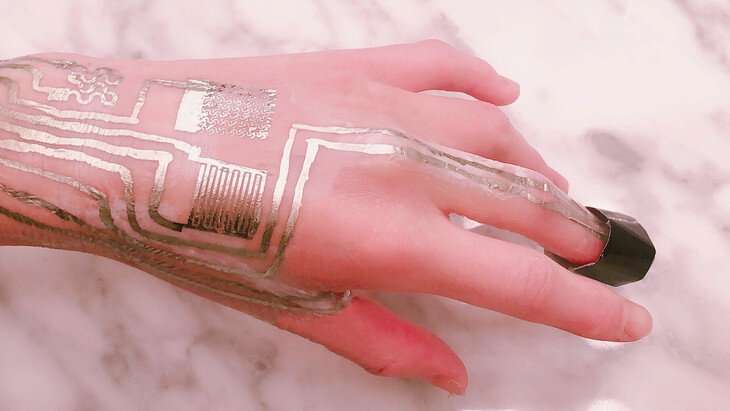An international team at Penn State led by [Larry Cheng] made a breakthrough in printing sensors directly on skin without heat. The breakthrough here is the development of a room-temperature sintering technique. Typical sintering of copper happens at 300 C, and can be further lowered to 100 C by adding nanoparticles. But even 100 C is too hot, since skin starts to burn at around 40 C.
You can obtain their journal article if you want the details, but basically their technique combines the ingredients in peelable face masks and eggshells. With this printed circuit is applied to the skin, the sintering process only requires a hair dryer on the cool setting, and results can bend and fold without breaking the connections. A hot shower will remove the circuit without damaging the circuit or your skin. [Larry] says the circuits can be recycled.
They are using these sensors to monitor temperature, humidity, blood oxygen levels, and heart performance indicators. They’ve even linked these various on-body sensors with a WiFi network for ease of monitoring. After reading this report, we’re left wondering, if the sensor is directly on your skin, can it be really called wearable?
We’ve written about printable inks before, but for printed circuit board applications. We can’t help but wonder if this technology would help solve some problems inherent in that technology, as well. Thanks to [Qes] for the tip.
















I think 40c is a little too low for burning skin. My bath is usually that warm.
The medical device standard IEC 60601-1 requires that parts applied to the patient not exceed 41C. As with most things in that standard, it’s overkill, but the idea is that someone with very poor blood flow *could* experience skin damage from a 41C object.
Maximum temperatures for applied parts are time and material related, 41C is the point where the temperature needs to be documented and considered in risk management but isn’t a limit. Metals and liquids limits are from 43C for durations over 10 min up to 51C for exposure under a minute. Touch accessible parts can be up to 74C for contact under 1 sec.
Yes it’s been known for elderly bedridden patients to get burns off electric blankets and heating pads, even on low, merely because their circulation isn’t removing heat from the contact areas or radiating it efficiently over periods of many minutes. Grandma sous vide is not what anyone wants to happen.
I wouldn’t like the idea of a mixture of nano particles (silver?) and PVA being heated into some kind of mixture on my skin. Some chemicals might penetrate into the skin?
As your skins surface is entirely shed and replaced rather frequently I don’t think this would be an issue – would have to get really really deep to stick around. Worth looking at, but as this is largely the stuff folks put on their skin deliberatly and have done for ages I don’t think it will be a problem.
Nor it is a good thing for them for the environmnet when they are rinsed off.
I don’t know about the other chemicals but PVA sounds a lot less scary when you pronounce it “elmer’s wood glue”. i wouldn’t eat it but i’ve never had any concern getting that stuff on my skin. honestly i’m more worried about it ruining my clothes if i drag a sleeve through it…
Not mentioned in the linked article is what the sheet resistance is. Low current, slow circuitry used on the skin may get by with high ohms/sq but to be useful for printing PCBs it needs to be less than what’s already out there. I’d be interested in their “high” temp sintering process. 40C might be too hot for skin but a PCB would certainly tolerate it.
So would 3D printing with it…